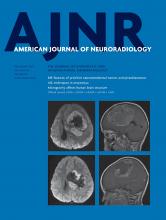Abstract
BACKGROUND AND PURPOSE: Supratentorial primitive neuroectodermal tumors and pineoblastomas have traditionally been grouped together for treatment purposes. Molecular profiling of these tumors has revealed a number of distinct entities and has led to the term “CNS-primitive neuroectodermal tumors” being removed from the 2016 World Health Organization classification. The purpose of this study was to describe the MR imaging findings of histologically diagnosed primitive neuroectodermal tumors and pineoblastomas and correlate them with molecular diagnoses and outcomes.
MATERIALS AND METHODS: Histologically diagnosed primitive neuroectodermal tumors and pineoblastomas were enrolled in this Children's Oncology Group Phase III trial, and molecular classification was retrospectively completed using DNA methylation profiling. MR imaging features were systematically studied and correlated with molecular diagnoses and survival.
RESULTS: Of the 85 patients enrolled, 56 met the inclusion criteria, in whom 28 tumors were in pineal and 28 in nonpineal locations. Methylation profiling revealed a variety of diagnoses, including pineoblastomas (n = 27), high-grade gliomas (n = 17), embryonal tumors (n = 7), atypical teratoid/rhabdoid tumors (n = 3), and ependymomas (n = 2). Thus, 39% overall and 71% of nonpineal tumor diagnoses were discrepant with histopathology. Tumor location, size, margins, and edema were predictors of embryonal-versus-nonembryonal tumors. Larger size and ill-defined margins correlated with poor event-free survival, while metastatic disease by MR imaging did not.
CONCLUSIONS: In nonpineal locations, only a minority of histologically diagnosed primitive neuroectodermal tumors are embryonal tumors; therefore, high-grade glioma or ependymoma should be high on the radiographic differential. An understanding of molecularly defined tumor entities and their relative frequencies and locations will help the radiologist make more accurate predictions of the tumor types.
ABBREVIATIONS:
- ATRT
- atypical teratoid/rhabdoid tumor
- EP
- ependymoma
- ET
- embryonal tumor
- ETMR
- embryonal tumor with multilayered rosettes
- GBM
- glioblastoma multiforme
- HGG
- high-grade glioma
- HGNET
- high-grade neuroepithelial tumor
- MB
- medulloblastoma
- NOS
- not otherwise specified
- PBL
- pineoblastoma
- PNET
- primitive neuroectodermal tumor
- © 2019 by American Journal of Neuroradiology
Indicates open access to non-subscribers at www.ajnr.org












